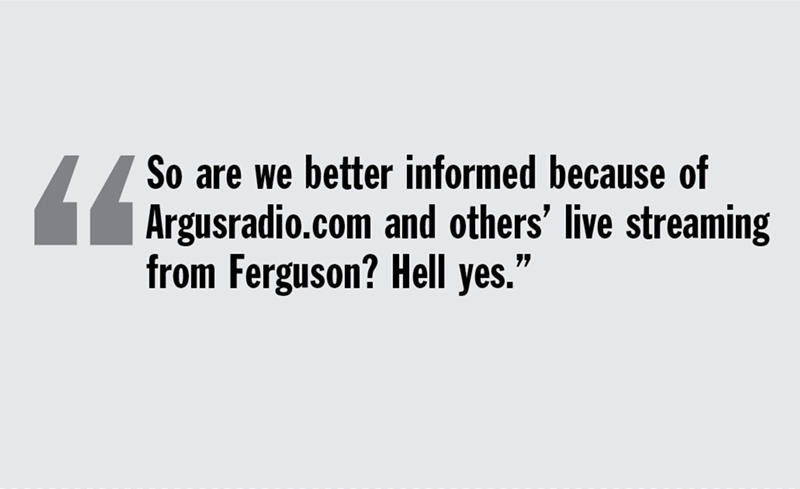Buried in old files from decades of teaching reporting and journalism ethics is a flyer mailed to local homes by pornographer Larry Flynt.
Filled with vivid images of war’s brutality, it was Flynt’s way of defining obscenity. A furor erupted.
That was such an innocent era. Pictures on paper. Mail.
Now we get online videos of public amputations, hangings, beheadings and mass killings that are brutal beyond anything Flynt ever published. The ubiquity of violence online rarely is mentioned.
If someone protests, it’s because an American is the victim but it’s soon forgotten. In that sense, photojournalist James Foley’s decapitation was the latest “reality” murder video. Does anyone remember journalist Daniel Pearl? Businessman Nick Berg?
They’re American victims we know about. Almost daily, however, Islamists in Syria or Iraq post still and video images of them executing Arab captives.
Last month, Islamists posted a video that they said showed scores of Syrian soldiers — stripped to their underwear — being marched into the desert and executed after their airbase fell to the jihadists.
Those images and their value as recruiting propaganda for Islamist killers is a dark side of democratizing video and online technology. Real, vivid and unmediated violence is the new chic. It’s obscenity without sex.
People watch it. So we’re drowning in violent “live” images from everywhere: dashboard cameras, wearable mini-cams, network shows like Cops and demonstrations/riots in this country as well as casualties in war zones and recruiting propaganda posted by jihadists. It doesn’t end there. Some online videos set the daily news agenda. We write about them and sometimes base stories on often-unverified videos. We do that although any journalist with worldly experience beyond a computer screen knows that an image can mislead as easily as inform.
Disturbing as this can be, social media and affordable and evolving technology also allow us to see beyond traditional TV reporting. So I was delighted by Laura Sydell’s recent NPR story about Argusradio.com, a four-person volunteer Internet radio station in St. Louis.
It purchased equipment to live stream local bands, Sydell said, but founder Mustafa Hussein turned his new gear on protests, rioting, arson and looting and police responses after Michael Brown was killed by a cop in Ferguson, Mo.
“We were only getting bits and pieces from the major networks,” Hussein told her. “And I knew we had the ability to share what I could see firsthand since I happen to be right here in St. Louis.”
Sydell said the night Hussein started livestreaming from the streets of Ferguson, some 1.3 million people tuned in to watch.
I’m sorry I missed it; our fishing camp in northeastern Ontario doesn’t have Internet.
Argus Radio uses technology from a company called Livestream whose CEO, Max Haot, said Argus set a record for them. “The audience and the rapid spread of the link and the speed at which the audience has built up is unprecedented,” he told Sydell. She reported that other people in Ferguson also downloaded Haot’s app and sent their own streams; Livestream’s service has averaged 2 million viewers a night for images from Ferguson.
In her interview with Haot, Sydell caught the substance of changes that new media create for reporting. It caught moments that might otherwise have been missed — like the night a St. Louis police officer pointed a rifle at Hussein and another journalist. That image found its way to YouTube and major media outlets, and the cop was suspended indefinitely.
“I think it really helps change the world in the way that people have a direct access with a breaking news event and (they) can make their own judgment,” Haot said.
Here’s the catch and it’s as old as photography: We saw what the camera in a particular place at a particular time captured. Such snapshots of reality recall a caution Jerry Springer offered my reporting students when he was anchor and commentator at WLWT: What we see on TV is true but not accurate, accurate but not true. We see what happened but rarely what was going on.
Argusradio.com’s best effort in Ferguson showed only what was in front of its camera. It was better than traditional TV news, but to draw the inevitable sports analogy we often see NFL player retaliation, not the original blow.
So are we better informed because of Argusradio.com and others’ live streaming from Ferguson? Hell yes. Do we know more about the over-the-top initial reaction by militarized local cops? Yes. Do we know any more about what happened when Officer Darren Wilson confronted Brown? No.
And still we base our judgments on finite information from diverse images. Just as we did with old media.
I missed Argusradio’s live streaming but I’ve deliberately avoided the James Foley execution video the same way I don’t need to see child abuse to understand its obscenity.
Larry Flynt was right.


